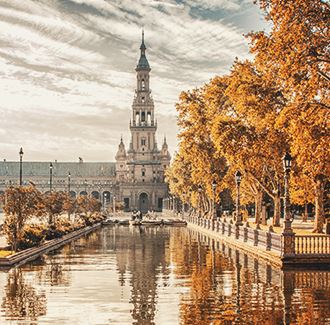
Living and Dancing in Seville
Dream, History and Art
The historical influence of the Moors can be felt in several locations and traditions, as well as everyday life.
The streets show us a city that served as a crossroads of different cultures over the centuries. Perhaps the best example of this is the Real Alcázar — a majestic palace complex where the legacy of History coexists with the boldness and creativity of the arts. This ancient fortress has been a royal residence since the 14th century and gradually became a dream landscape with beautiful Moorish-style buildings and refreshing gardens filled with statues and fountains. The scenery is evocative of several different time periods and cultures, with a focus on mudéjar architecture.



Gastronomy
When dinner time comes, you should begin your flavour tour — after all, Seville is known for its food and wine culture, which benefit from the rich ingredients coming from the surrounding farm regions as well as centuries of History and mixing between Arabic and Iberian gastronomical traditions. The highlight goes to culinary delights such as the Gazpacho Andaluz (a fresh tomato soup), the iconic tortillas, several pork meat dishes and delicious tapas such as Jamón Ibérico. Besides the regional wines, Sevillans also enjoy manzanilla, a popular local fortified wine.


Between Faith… and Dancing!
But don’t have too much to eat, because later you might have to dance! It is impossible to visit this city without experiencing Flamenco. This emotional style of folk music and dance had its origin in the gypsy people, who arrived at the Iberian Peninsula in the Middle Ages after the Moorish conquest. The music is melancholic yet rhythmic, played with guitars, hand claps and percussions and including melodic singing. The other element of Flamenco is its vigorous dancing style that include fast movements, sensuous motions and tap dancing by both male and female performers wearing colourful traditional clothing.

To learn more about Flamenco, head for the Museo del Baile Flamenco. In this museum you can get to know the History of Flamenco, watch performances and even attend music and dance classes!
But while Flamenco represents the profane side of Seville, one must also not forget the city’s deeply religious element, which is more evident during Semana Santa (Holy Week): one most important local events, attracting tens of thousands of people from all over the country. During the Catholic Easter period, the streets are filled with crowds taking part of religious processions led by the nazarenos — men who parade the streets wearing austere hooded religious clothes. Each quarter of the city is home to different groups (confrarias) of these men who lead the processions and cross the city’s streets with religious decorative floats and images of the Virgin Mary.


